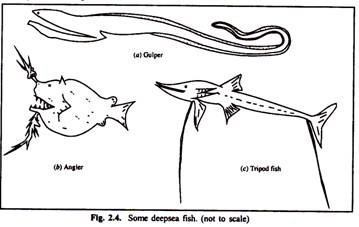ADVERTISEMENTS:
In this article we will discuss about the structure of Lycopodium with the help of diagrams.
The main plant body is sporophytic. It consists of slender and branched stem, numerous small leaves (microphylls) and dichotomously- branched roots (Fig. 7.23A, B).
Roots:
ADVERTISEMENTS:
The primary root or first formed root of the young sporophyte is ephemeral, short-lived. The older plants have dichotomously branched adventitious roots (the roots are endogenous in origin and are formed from the pericycle).
In case of erect species like Lycopodium selago and Lycopodium compactum, the root arises from the basal part of the stem. However, the species with prostrate creeping stem e.g., Lycopodium clavatum and Lycopodium cernuum, bear roots all along its length.
Anatomically, the root is divided into three parts — the outer epidermis, middle cortex and inner stele (Fig. 7.24A).
ADVERTISEMENTS:
The outer epidermis is made up of a single- layered thin-walled parenchymatous cells. Numerous root hairs are given out from the epidermal cells of the apical region of the root. A peculiarity of the root of Lycopodium is that the root hairs arise in pairs.
Next to the epidermis is the cortex which is several layers in thickness. In older roots, the cortex is differentiated into outer and inner cortex. The outer cortex usually consists of heavily scarified cells. This sclerified region provides mechanical support to the root. The inner cortex is parenchymatous.
The central portion of the root is occupied by protostele. The stele is monarch with one pro- toxylem group in young roots, but becomes diarch or triarch in older roots. The xylem is ‘C’ or ‘U’ shaped with the protoxylem at the tips of ‘C’ or ‘U’. The phloem lies in between the arms of the xylem.
Leaf:
The leaves are simple, eligulate, sessile and small with a single unbranched mid-vein (microphyIIs). They are generally lanceolate in shape with a narrow apex and slightly broad base. The margins are generally entire but sometimes serrated in nature (e.g., L. serratum).
Phyllotaxy is basically helical (L. clavatum), but the arrangement may appear to be opposite decussate (L. complanatum, L. alpinum) or whorled (L. cernuum), or even variable in different regions of the same plant. In some forms the leaf bases are decurrent (the leaf base is fused with and extends down the stem to varying degrees).
The leaves are usually all alike and all of same size and shape (Isophylly or Homophylly). In some species, specially those with flattened stems, e.g., L. complanatum and L. volubile, the leaves show dimorphism (Anisophylly or Heterophylly) — particularly on lateral determinate branches.
The anatomy of the leaf is very simple with a highly cuticularised one-layered epidermis, interrupted by stomata, a homogeneous parenchymatous mesophyll with large intercellular spaces and chloroplastids; and a median concentric vascular bundle with central xylem surrounded by phloem (Fig. 7.24B).
Stomata are distributed on both the surfaces of the leaf (i.e., amphistomatic) in most of species, but in some species (e.g., L. complanatum and L. volubile) stomata are confined to the lower surface only (i.e., hypostomatic).
ADVERTISEMENTS:
Stem:
The stem of all the species of Lycopodium are in general weak, slender and rhizomatous. It is usually erect (e.g., L. selage) or pendent (e.g., L. phlegmaria) in the sub-genus Urostachya and prostrate creeping in the sub-genus Rhopalostachya, which is sparsely (e.g., L. annotinum) or profusely branched (e.g., L. obscurus).
In the members of the sub-genus Urostachya the branching is typically dichotomous, but in Rhopalostachya it is first dichotomous, which later becomes monopodia! (Table 7.3). The stem and branches are covered with small leaves (microphylls).
Anatomically, the stem is differentiated into epidermis, cortex and stele (Fig. 7.25A). The outermost layer is a uniseriate epidermis, the walls of which are thick and cuticularised. The cortex is highly variable in thickness and structure.
In some species it becomes homogeneous made up of parenchymatous cells (e.g., L. phlegmaria, L. serratum), and in others the cells of specific regions undergo sclerification. In some species, e.g., L. clavatum, the outer and inner portions of the cortex are composed of thick-walled sclerenchymatous cells whereas the middle portion consists of large, thin-walled parenchymatous cells (Fig. 7.25A).
In L. cernuum, on the other- hand, the middle portion is sclerenchymatous in nature, while the inner and outer zones are parenchymatous. The endodermis is the innermost layer of the cortex showing characteristic casparian bands. The endodermis is followed by pericycle which is 2-6 layered thick. The transition from pericycle to cortex in some species (e.g., L. clavatum) is abrupt because the walls of the cortical cells are thick.
The stele is protostelic (without pith) in nature; however, the arrangement of the vascular tissues, i.e., xylem, phloem and associated parenchyma within the stele, varies greatly from species to species and even within the same species:
ADVERTISEMENTS:
(a) Actinostele:
Xylem is star-shaped with protoxylem at the tips of the star- shaped projections and phloem completely surrounds the xylem e.g., L. selago, L. serratum (Fig. 7.25Ba), L. phlegmaria.
(b) Plectostele:
Xylem breaks up into separate plates. Phloem not only surrounds the xylem but also is distributed between the plates of the xylem e.g., L. volubile, L. clavatum (Fig. 7.25A), L. camplanatum.
ADVERTISEMENTS:
(c) Mixed Protostele:
The xylem and phloem are intermixed and xylem form scattered masses e.g., L. cernuum (Fig. 7.25Bc), L. laterale.
(d) Stellate Form:
Stellate xylem cylinder is irregularly broken up into several strands e.g., L. annotinum (Fig. 7.25Bb); L. lucidulum.
With the exception of ferns, Lycopodium is the only lower vascular plant which exhibits such variations in the pattern of primary xylem and phloem in stems.



